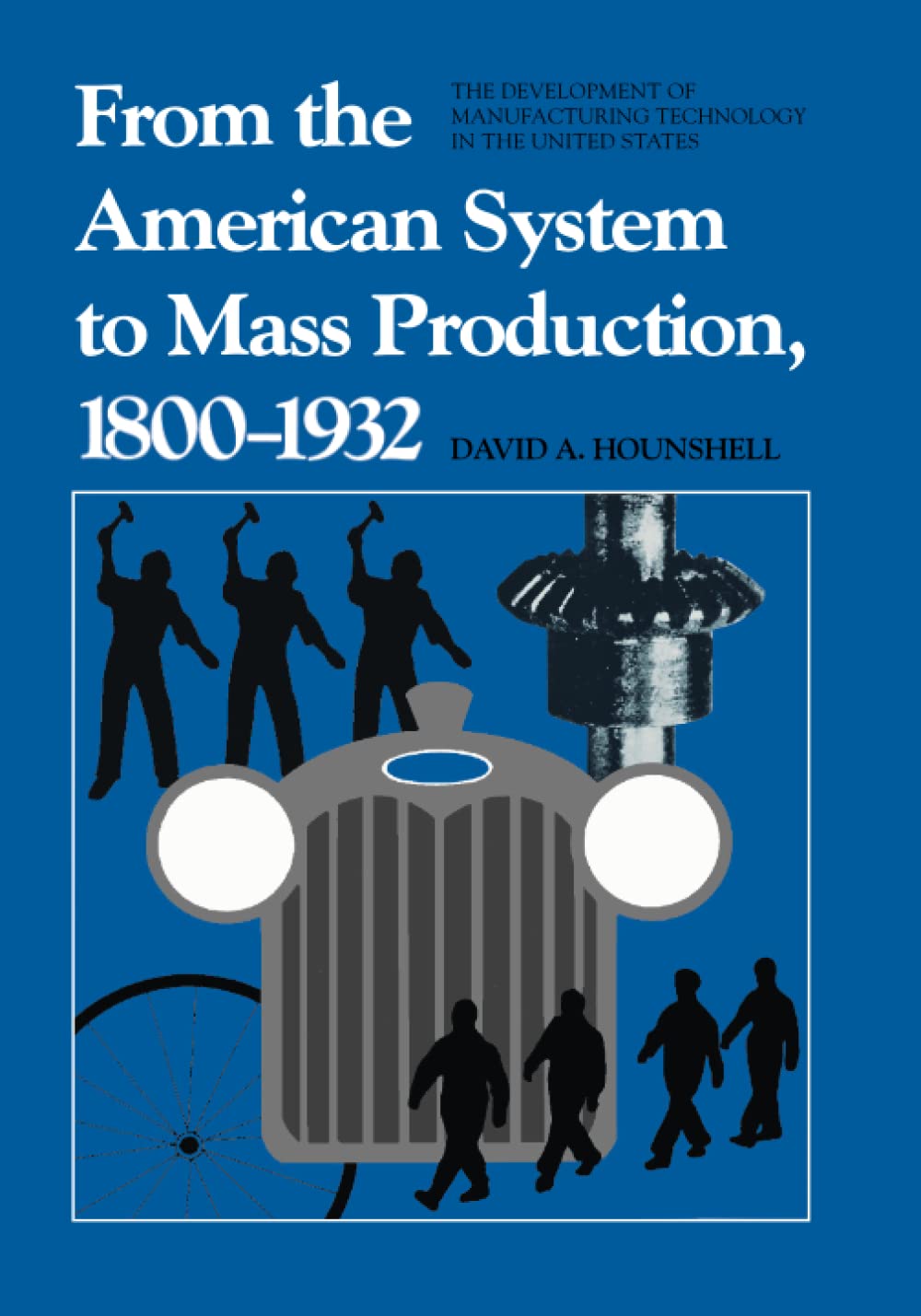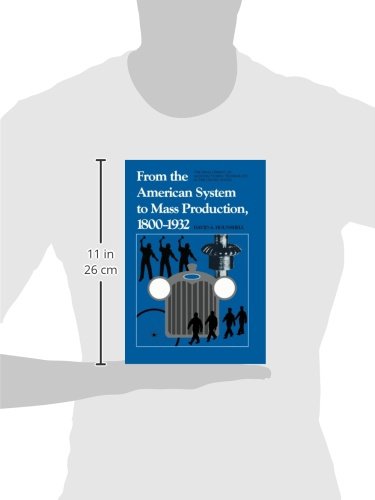



From the American System to Mass Production, 1800-1932: The Development of Manufacturing Technology in the United States: 4
J**R
Comprehensive and well organized
Takes time to tell the story about the advancement and diffusion of manufacturing techniques. I've previously read other, faster moving histories like Roger Burlingame's "Machines that Built America" and was looking for more depth - this delivered!
A**R
A great book
Having only read the first bit it has all the infomation that I was looking for and more in one book, if you want to find out more from the TV series War Factories this will give you an Idea of what was already in place before WW2
H**R
Eli's not comin'
I don't know if school history still teaches that Eli Whitney invented mass production using interchangeable parts, the way it happened in the '60s, but the real story is far more complicated and interesting. Seldom have I read a revisionist history so completely convincing as David Hounshell's "From the American System to Mass Production."True, it was published 25 years ago, so I am just catching up. Part of the reason Hounshell is so persuasive is that not only did he make use of corporate documents, but he also was able to take apart a couple of century-old Singer sewing machines at the Smithsonian Institution to see if their parts interchanged. They did not.If all he had done had been to debunk Whitney, it would not be worth spending 400 pages -- lavishly illustrated pages though they are -- with the book. "From the American System" has a trajectory reminiscent of a Greek play -- not necessarily a tragedy -- with a surprising outcome: After a century of strenuous effort to invent mass production, the system failed within 13 years.The argument is nuanced. As Henry Ford and his engineers, who put the cap on mass production by inventing the assembly line in 1913, said at the time, mass production was not merely quantity production. Singer had achieved quantity production in the 1880s without even adopting the American system, although after reaching about 500,000 units per year it did have to adopt it.The story begins in England, where Marc Brunel broke down the craft of making reeving blocks for the Royal Navy into 22 operations, each performed by a specialized machine. Significantly, it was a military demand. The U.S. War Department was instrumental in pushing for mass production by means of interchangeable parts, although for the first 50 years it did not get it.Even managing to make truly interchangeable parts, which John Hall did at Harpers Ferry in the 1840s, did not mean large production or lower costs. It was the interchangeability itself that was the goal of the army.Later, Ford used interchangeability, along with single-purpose tools, carefully orchestrated work routines and -- the capstone -- the moving assembly line, to drive costs lower and lower.Hounshell traces the development through the national and private armories in New England, which influenced sewing machine manufacturers in the `50s. A patent cartel allowed the sewing machine companies to make enormous profits, which perhaps (Hounshell does not make this point) militated against a drive for the lowest cost production. Singer, and others, continually drove down costs, but only by a process of semi-rationalization, with some machine work but still using "fitters" to make the final assembly.One other manufacturer, Brown & Sharpe, adopted something closer to the American system and competed on costs (apparently) but not on marketing. Throughout, Hounshell emphasizes that business success went not to the firm that was most efficient but to the one that had the best sales and marketing system.There comes an odd interlude with McCormick farm implements, where the production manager, Leander McCormick, argued for decades against expanding production. His arguments sound odd today, and eventually his brother Cyrus fired him. Production soared tenfold.Then came bicycles. The design innovations were all European, as was the new technique of stamping steel parts. Eastern makers stuck by the American system, but Western Wheel Works in the Midwest moved decisively toward pressed steel parts. The bicycle business collapsed in 1898, lasting just long enough, and in just the right place, to pass on pressed steel to the auto factories.Ford, however, went down a blind alley. In order to drive production costs as low as possible, he had to resist multiplication of products, and General Motors ate his lunch with the tiered marketing strategy and frequent style changes.Hounshell does more than tell the story of manufacturing technology, however. There is much here about corporate organization and governance, labor adaptations to the factory system and the social (but not the political) impacts of mass production. "From the American System to Mass Production" should be read alongside Sean Wilentz' "Chants Democratic" for the reaction of craft workers who were displaced by mass production.Although it appears that the total number of craft workers actually expanded. The new factories required large numbers of designers, patternmakers, tool and die cutters and millwrights. Although Hounshell does not say so, the machine minders were not, in the end, displaced artisans alienated from their tools but farm boys (and some girls), many from Europe, who would never have been skilled workers anyway.Because mass production emerged in Detroit, and because it failed there, the book, despite its age, resonates vibrantly with what is happening in Detroit in 2008-2009.And, although Hounshell only alludes to it without thorough analysis, the phenomenon of mass consumption also resonates deeply with business conditions today.Hounshell published just as Ronald Reagan established a national policy of disciplining labor by exporting jobs overseas. Instead of encouraging American business, the supposed party of business overthrew a policy almost as old as the republic in the name of ideological foolishness and the deliberate supremacy of finance over production. GM, the victor over Fordism, had led the way 30 years earlier by elevating a financier instead of an engineer to the top.The decline of GM, once the world's biggest corporation, began then. The sickness of GM was evident by the early `60s, and the company was moribund by the time Reaganomics came in. Anybody could have seen what had to come next. It's too bad ,more people did not read Hounshell when his book was new.
T**I
From Springfield to Detroit
The United States emerged as an industrial colossus in the early twentieth century. An important component of that rise was the development of mass production, which was pioneered in the automotive industry, specifically Henry Ford’s Model T. In his book “From the American System to Mass Production, 1800-1932: The Development of Manufacturing Technology in the United States” (1984), David Hounshell argues that the Model T assembly line was, in fact, the culmination of a century-long precision manufacturing development process first begun in federal armories in the 1790s.The armories – one in Springfield, Massachusetts (1794), the other in Harpers Ferry, Virginia (1798) – sought the perfect interchangeability of musket parts. The goal was to strip down ten weapons, mix all the parts together, and then re-assemble them from whichever part you happened to pull from the pile. The production of such perfectly interchangeable parts required special purpose-built machines, but also jigs, fixtures, and gauges. This method of special purpose-machinery and uniformity became known as the American system and was purposively unlike the existing “European system,” which stressed individual craftsmanship and meticulous finishing. In the later immortal words of Henry Ford: “in mass production there are no fitters.” It was the difference between “building” something and “manufacturing” it. “This system had come about,” Hounshell writes, “only after a forty- to fifty-year period of relentless effort on the part of the United States government to realize in practice a technical-military ideal that was born in Enlightenment France.”Beginning in 1765 a French artillery general by the name of Jean-Baptiste de Gribeauval sought to rationalize French armaments by introducing standardized weapons with uniform parts. It would take nearly a century to achieve Gribeauval’s lofty ambition. “French military thought and practice played a paramount role in the United States military during the early national period,” Hounshell says. Almost immediately after independence the War Department began to demand interchangeability and mechanization in small arms production. Between 1794 and 1815, Hounshell says the Springfield armory had transformed armsmaking from “a craft pursuit into an industrial discipline and the weapon from a shop creation into a factory product.”American efforts at precise uniformity in production did not go unnoticed. In 1853, the British Select Committee on Small Arms toured American armories and were particularly impressed with the workable, mechanized system of uniform firearms manufacturing developed in Springfield. That said, Hounshell notes that true interchangeability remained illusory for a long time. Even the superintendent of the famed Colt factory in Hartford, Connecticut, which drew on long established methods used at Springfield and opened in 1855, once quipped, “I have heard of [interchangeability], but I defy a man to show me a case.”An entire generation of young mechanics learned this approach to manufacturing at the armories, especially the one in Springfield. They would go on to play critical roles in other burgeoning industries of the nineteenth century that required complex manufacturing, such as sewing machines, farming equipment, and bicycles. Interestingly, for most of the nineteenth century, the American system did not result in large scale production at low cost. In fact, many of the companies that came to dominate their industries, such as Singer sewing machine, McCormick reapers, and Pope bicycles, actually achieved their early growth and dominant market position by a combination of quality and largely handmade production, along with superior marketing and sales operations. Most sold their product at the top end of the industry price range and at a generous profit margin. Singer, for instance, priced their standard sewing machine at five to ten times the cost of production. This was true even in cases where early market entrants, such as Wheeler and Wilson and Willcox & Gibbs, adopted highly refined armory practices in the 1850s, whereas Singer, the overwhelmingly dominant firm (70% market share), did not do so until 1873. In its first year of production in 1853, Singer produced 813 sewing machines. In 1872, using mainly the so-called European method of production – that is, with general machine tools and with much handwork and fitting rather than with special tools, jigs, and fixtures – the company produced almost 220,000 machines. The number more than doubled to 500,000 just seven years later after they adopted the American system at their new manufacturing facility at Elizabethport, New Jersey.Henry Leland exemplified how the armory system ramified across American manufacturing in the half century after the Civil War. He began his career as a tool builder at the Springfield armory during the Civil War. After that, he moved to the Colt factory in Hartford where he worked in the machine shop that manufactured revolvers. From there he moved to Brown & Sharpe where he ran the screw machine section for the Willcox & Gibbs sewing machine, which remained in production until 1950. Finally, Leland founded the Cadillac Motor Car Company in Detroit in 1902. Thus, Leland is a real world example of the Springfield to Detroit journey.The McCormick Harvesting Machine Company followed a similar manufacturing trajectory as Singer Sewing Machines. For almost half-a-century the McCormick works in Chicago operated like “a large country blacksmith shop.” Until 1880, Hounshell says, production of the market-leading McCormick reaper depended entirely on “skilled blacksmiths, skilled machinists, and skilled woodworkers.” Moreover, design improvements often required significant model changes year to year making high volume production impossible. It was only after founder Cyrus McCormick fired his younger brother, Leander, as factory superintendent in 1880 that production moved to adopt more sophisticated New England armory techniques. “Leander McCormick in 1880 was still very much the Virginia blacksmith he had been when he first arrived in Chicago in 1848,” Hounshshell says, “the factory’s operations reflected his background.” The new superintendent, Lewis Wilkinson, on the other hand, had learned his craft at the Colt armory in Hartford and the Wilson Sewing Machine Company, both exemplars of the American system. Wilkerson would tutor Cyrus McCormick Jr. on the value of single purpose, machine tools for large-scale manufacturing. In 1882, production jumped over 50 percent in one year to 46,000 units. By 1902, production under the younger McCormick had increased over 500 percent.The United States experienced a decade-long “bicycle craze” in the late nineteenth century. Several manufacturers of sewing machines and farming equipment that were getting clobbered by the new-and-improved mechanized production at Singer and McCormick tried their hand at making bicycles instead. In 1887, the unstable, large-wheeled “ordinary” bicycle was eclipsed by the two-wheeled, chain-driven “safety” model that we’re all familiar with today – and demand exploded. At its peak a decade later, over 300 American bicycle companies were producing over one million “safety” bicycles a year. Hounshells says that the bicycle industry, while short-lived, was critical and “transitional” for the development of mass production. Innovative bicycle makers, such as Pope Manufacturing Company in Hartford, developed important production techniques involving ball bearings and sheet steel pressing/stamping technology, which Hounshell says ushered in a “revolution in metalworking.” “Taken together,” the author writes, “refined armory practice and well-developed stamping techniques provided the technical basis for automobile manufacturing in the early twentieth century … Both the bicycle and bicycle production technology provided the basis for the age of the automobile in America.” But the automobile industry still needed to solve a production problem that bedeviled scores of bicycle-makers in the 1890s: How to maintain fast, efficient, and effective assembly.Houshnell says that the Ford production system and its related high cost labor – collectively known at the time as Fordism – literally “changed the world.” Various things led to the creation of the Model T assembly line, including the American system of uniform parts production and Chicago meatpacker’s disassembly lines (although Hounshell says that the popular factory management system called Taylorism had little to do with it), but the final product was the result of relentless experimentation. Hounshell says the assembly line at the Highland Park Factory “somehow suddenly dropped out of the sky” on April 1, 1913. In other words, the assembly line was not invented; it evolved from a variety of existing practices and new techniques. However, just as Lewis Wilkinson’s short tenure at McCormick left a deep and lasting impression on the manufacturing process in Chicago, the same happened with a former Singer machinist named Walter Flanders at Ford Motor Company in the years immediately preceding the introduction of the Model T. Houshnell says that Flanders indoctrinated the Ford Highland Park Factory with a refined version of New England armory practice.The production figures for the Model T are staggering. In 1908, Ford sold 6,000 at a price of $850. In 1916, three years after the introduction of the assembly line, Ford sold almost 600,000 Model T’s at $360. Simplicity, speed, and especially accuracy were the hallmarks of Fordism. “Accuracy provided the rock upon which the mass production of the Model T was based,” Hounshell says. Eventually, a Model T was rolling off the assembly line every forty seconds. Ford was surprisingly open about their revolutionary production system and the techniques spread quickly throughout the automotive industry and beyond.Ford eventually became a victim of their own success. Customers came to demand better style and design in their cars and General Motors taught them to expect annual model changes, too. Ford had designed a system to produce just one thing and to produce it very quickly and accurately. When, in 1927, Henry Ford finally conceded that the company needed a new model, the company had to shut down for six months to achieve the changeover. In the process, Henry Ford fired most of the men responsible for the Model T’s phenomenal success. After the introduction of the Model A, Ford’s market share, which had soared as high as 60% in the early 1920s, plummeted to under 15%. Less than five million Model A’s were made, even though Hounshell says it was “a well-designed, well-made, well-priced, ‘thoroughly up to date’ automobile” and the massive River Rouge plant eventually made more Model A’s in one month (180,000) than had ever been made for the Model T.Hounshell says that the century-long road from Springfield to Detroit was “neither short nor direct.” However, the “uniformity principle” and special-purpose machines played a central role in the journey from beginning to end. The American system and eventually the assembly line were essential to mass production, although clearly they were not required for business success as such leading enterprises as Singer and McCormick came to dominate their industries because of advantages in sales and marketing, not armory-style production.
P**J
The under reported story of the Second Industrial Revolution
This is an outstanding work, thoroughly researched and well written. The photos and illustrations add much to the telling of the story.The evolution from interchangeable parts to mass production and then to flexible manufacturing is an underappreciated aspect of the history of technology. Hounshell traces the evolution from firearms through sewing machines, reapers, bicycles and automobiles. There is also good coverage of machine tools and the development of the assembly line.This is also a good business book with lessons about strategic thinking, planning and marketing.Lastly, the history of Ford Motor Co. and its iconic founder Henry Ford is a fascinating part of cultural history.